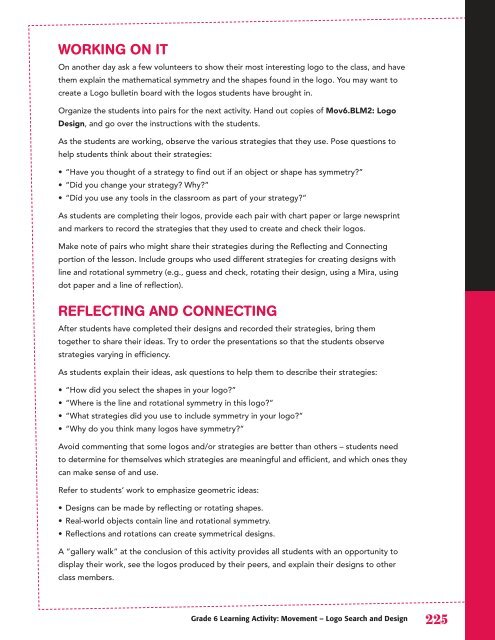Geometry and Spatial Sense, Grades 4 to 6 - EduGains
Geometry and Spatial Sense, Grades 4 to 6 - EduGains
Geometry and Spatial Sense, Grades 4 to 6 - EduGains
Create successful ePaper yourself
Turn your PDF publications into a flip-book with our unique Google optimized e-Paper software.
WORKING ON IT<br />
On another day ask a few volunteers <strong>to</strong> show their most interesting logo <strong>to</strong> the class, <strong>and</strong> have<br />
them explain the mathematical symmetry <strong>and</strong> the shapes found in the logo. You may want <strong>to</strong><br />
create a Logo bulletin board with the logos students have brought in.<br />
Organize the students in<strong>to</strong> pairs for the next activity. H<strong>and</strong> out copies of Mov6.BLM2: Logo<br />
Design, <strong>and</strong> go over the instructions with the students.<br />
As the students are working, observe the various strategies that they use. Pose questions <strong>to</strong><br />
help students think about their strategies:<br />
• “Have you thought of a strategy <strong>to</strong> find out if an object or shape has symmetry?”<br />
• “Did you change your strategy? Why?”<br />
• “Did you use any <strong>to</strong>ols in the classroom as part of your strategy?”<br />
As students are completing their logos, provide each pair with chart paper or large newsprint<br />
<strong>and</strong> markers <strong>to</strong> record the strategies that they used <strong>to</strong> create <strong>and</strong> check their logos.<br />
Make note of pairs who might share their strategies during the Reflecting <strong>and</strong> Connecting<br />
portion of the lesson. Include groups who used different strategies for creating designs with<br />
line <strong>and</strong> rotational symmetry (e.g., guess <strong>and</strong> check, rotating their design, using a Mira, using<br />
dot paper <strong>and</strong> a line of reflection).<br />
REFLECTING AND CONNECTING<br />
After students have completed their designs <strong>and</strong> recorded their strategies, bring them<br />
<strong>to</strong>gether <strong>to</strong> share their ideas. Try <strong>to</strong> order the presentations so that the students observe<br />
strategies varying in efficiency.<br />
As students explain their ideas, ask questions <strong>to</strong> help them <strong>to</strong> describe their strategies:<br />
• “How did you select the shapes in your logo?”<br />
• “Where is the line <strong>and</strong> rotational symmetry in this logo?”<br />
• “What strategies did you use <strong>to</strong> include symmetry in your logo?”<br />
• “Why do you think many logos have symmetry?”<br />
Avoid commenting that some logos <strong>and</strong>/or strategies are better than others – students need<br />
<strong>to</strong> determine for themselves which strategies are meaningful <strong>and</strong> efficient, <strong>and</strong> which ones they<br />
can make sense of <strong>and</strong> use.<br />
Refer <strong>to</strong> students’ work <strong>to</strong> emphasize geometric ideas:<br />
• Designs can be made by reflecting or rotating shapes.<br />
• Real-world objects contain line <strong>and</strong> rotational symmetry.<br />
• Reflections <strong>and</strong> rotations can create symmetrical designs.<br />
A “gallery walk” at the conclusion of this activity provides all students with an opportunity <strong>to</strong><br />
display their work, see the logos produced by their peers, <strong>and</strong> explain their designs <strong>to</strong> other<br />
class members.<br />
Grade 6 Learning Activity: Movement – Logo Search <strong>and</strong> Design 22

















